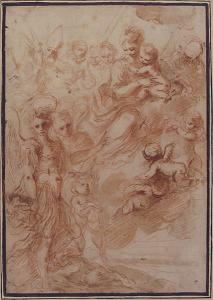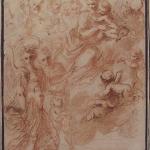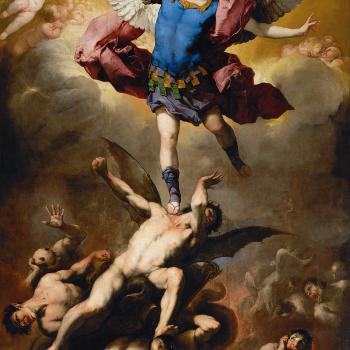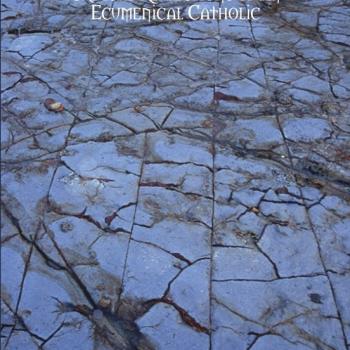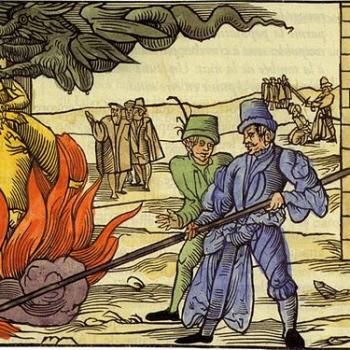13. Dead Biblical Heroes Return to Earth!: Samuel & Saul / Moses & Elijah at Jesus’ Transfiguration
Lucas Banzoli is a very active Brazilian anti-Catholic polemicist, who holds to basically a Seventh-Day Adventist theology, whereby there is no such thing as a soul that consciously exists outside of a body, and no hell (soul sleep and annihilationism). This leads him to a Christology which is deficient and heterodox in terms of Christ’s human nature after His death. He has a Master’s degree in theology, a degree and postgraduate work in history, a license in letters, and is a history teacher, author of 25 books, as well as blogmaster (but now inactive) for six blogs. He’s active on YouTube.
This is my 49th refutation of Banzoli’s writings. From 5-25-22 until 11-12-22 (almost half a year) he didn’t write even one single word in reply. Since then he has counter-responded three times. Why so few and so late? Well, he says it’s because my articles are “without exception poor, superficial and weak . . . only a severely cognitively impaired person would be inclined to take” them “seriously.” He didn’t “waste time reading” 37 of my first 40 replies (three articles being his proof of the worthlessness of all of my 4,000+ articles and 51 books). He also denied that I had a “job” and claimed that I didn’t “work.” But he concluded that replying to me is so “entertaining” that he resolved to “make a point of rebutting” my articles “one by one.” I disposed of his relentlessly false personal insults in Facebook posts dated 11-13-22 and 11-15-22 and 11-23-22.
My current effort is a major multi-part response to Banzoli’s 1900-page self-published book, The Legend of the Immortality of the Soul [A Lenda da Imortalidade da Alma], published on 1 August 2022. He claims to have “cover[ed] in depth all the immortalist arguments” and to have “present[ed] all the biblical proofs of the death of the soul . . .” and he confidently asserted: “the immortality of the soul is at the root of almost all destructive deception and false religion.” He himself admits on page 18 of his Introduction that what he is opposing is held by “nearly all the Christians in the world.” A sincere unbiblical error (and I assume his sincerity) is no less dangerous than a deliberate lie, and we apologists will be “judged with greater strictness” for any false teachings that we spread (Jas 3:1).
I use RSV for the Bible passages (including ones that Banzoli cites) unless otherwise indicated. Google Translate is utilized to render Lucas’ Portugese into English. Occasionally I slightly modify clearly inadequate translations, so that his words will read more smoothly and meaningfully in English. His words will be in blue.
*****
See the other installments:
See also the related articles:
Seven Replies Re Interceding Saints (vs. Lucas Banzoli) [5-25-22]
Answer to Banzoli’s “Challenge” Re Intercession of Saints [9-20-22]
Bible on Praying Straight to God (vs. Lucas Banzoli) [9-21-22]
Reply to Banzoli’s “Analyzing the ‘evidence’ of saints’ intercession” [9-22-22]
*****
• Samuel’s “appearance” to the medium of Endor
In the eagerness to find at any cost the dualistic concept of “spirit” in the Bible, some immortalists have resorted to the “apparition” of Samuel to the necromancer of Endor: a measure so desperate that it scandalizes even other immortalists. The text in question is found throughout chapter 28 of 1st Samuel, where the name of the prophet is mentioned six times as “answering” the call of medium. This is a full plate for spiritists, so much so that in the apologetic environment even most immortalists themselves understand that it was not Samuel who really appeared on this occasion, but rather, a demon disguised in the figure of the prophet. (p. 353)
Sure, there are different opinions about this, just as there are on the question of whether the story of Lazarus and the rich man is a parable or not. Honest differences among equally able exegetes occur. When they do, we can only make our best exegetical arguments for our own opinions. I have several to offer. I brought this up in Part 4, but for readers’ convenience I’ll paste it here again:
The prophet Samuel appeared after death to King Saul (1 Sam 28:5-20). I wrote in a 2017 article about this:
The text treats Samuel as the real person. Samuel gives a true prophecy. . . . Saul wasn’t killed because of the [forbidden] seance [that he requested], but because of his prior sins:
1 Samuel 28:16-19 And Samuel said, “Why then do you ask me, since the LORD has turned from you and become your enemy? [17] The LORD has done to you as he spoke by me; for the LORD has torn the kingdom out of your hand, and given it to your neighbor, David. [18] Because you did not obey the voice of the LORD, and did not carry out his fierce wrath against Am’alek, therefore the LORD has done this thing to you this day. [19] Moreover the LORD will give Israel also with you into the hand of the Philistines; and tomorrow you and your sons shall be with me; the LORD will give the army of Israel also into the hand of the Philistines.
. . . God allowed a dead saint to appear to the living. Whether Saul used a medium and sinned in that way is beside the point of the real Samuel appearing and giving a true prophecy. All agree that seances and other practices of the occult and sorcery, necromancy, etc., are forbidden. . . . The Samuel-Saul encounter was nevertheless a real one. It wasn’t a demon impersonating Samuel, because demons don’t utter true prophecies of judgment. . . .
I often use the event with Saul and Samuel to prove that Saints do know what is going on and that they are in communication with God. The former is evidenced by Samuel knowing what was and what had been happening to Saul and the latter is evidenced by Samuel knowing what was about to happen to Saul and his sons. . . . [therefore he was in existence as a conscious soul after death]
The witch certainly did not have the power to bring Samuel into existence if he was not already in existence, or to make Samuel aware of everything that had been and was happening to Saul, or to make Samuel aware of what was about to befall Saul and his sons. . . .
To this list of arguments I would add:
1) When the medium “saw Samuel, she cried out with a loud voice” (1 Sam 28:12); in other words, she was surprised, and she was because this was different from her usual spirits conjured up, since it was a real person, and a known one in Israel: a prophet.
2) The text always calls this person (or supposed demon) “Samuel” and does so five times (28:12, 14-16, 20). It never gives the slightest hint that the person or spirit it calls “Samuel” is anything or anyone other than the actual prophet Samuel. Certainly, this would be required, so as not to mislead the reader, if in fact it was a demon.
3) Beyond giving what was a true prophecy, Samuel invokes “the LORD” in a pious, orthodox fashion, seven times (28:16-19). A demon simply would never do that.
4) Samuel also refers back to his past prophetic words of warning to Saul, while he was still alive on the earth: “The LORD has done to you as he spoke by me . . . you did not obey the voice of the LORD, and did not carry out his fierce wrath against Am’alek . . .” (28:17-18).
5) Saul recognizes Samuel (whom he knew very well): “Saul knew that it was Samuel, and he bowed with his face to the ground, and did obeisance” (28:14).
Jamieson-Fausset-Brown Bible Commentary asserts:
[M]any eminent writers (considering that the apparition came before her arts were put in practice; that she herself was surprised and alarmed; that the prediction of Saul’s own death and the defeat of his forces was confidently made), are of [the] opinion that Samuel really appeared.
Banzoli — if he is true to constant (and boorish) form — won’t care that “many eminent writers” agree with my view that this really was Samuel. He’ll just say it was a conspiracy of all of these Bible commentators to conceal the truth (uniquely obvious to him), just as he thinks about virtually all Bible translators. He (for who knows what reason) thinks that he knows better than all. If they disagree with him, one and all are a pack of biblically illiterate and “ignorant” liars and nefarious conspirators.
Needless to say, this is abominable “research.” And as we’ve seen, this extremely anti-traditional (and, I would say, anti-biblical) skepticism and radicalism has led Banzoli into Christological heresy and denial that the angels are immaterial spirits. I fully expect to fund more serious heresy as I make my way (by God’s grace only) through this tedious, very low-quality, hyper-repetitious book (which desperately needs an editor, but since it’s self-published . . .).
Matthew 17:-1-4 And after six days Jesus took with him Peter and James and John his brother, and led them up a high mountain apart. [2] And he was transfigured before them, and his face shone like the sun, and his garments became white as light. [3] And behold, there appeared to them Moses and Eli’jah, talking with him. [4] And Peter said to Jesus, “Lord, it is well that we are here; if you wish, I will make three booths here, one for you and one for Moses and one for Eli’jah.”
One of the most used texts in defense of the immortalist concept of spirit is the appearance of Moses on the Mount of Transfiguration, together with Elijah, . . . (p. 377)
It is the appearance of Moses that causes perplexity, because he was not taken alive into heaven like Elijah, for his death is expressly narrated in the Bible (Deut 34:5). Thus, he should among those who would only return to life in the final resurrection, since his spirit, by itself, is not a person who carries consciousness after death. Therefore, not a few immortalists . . . use this verse out of context to say that the spirit of Moses descended on the mount. But could it be that a little incorporeal ghost descended on the mountain of transfiguration in the sight of the disciples? We have many reasons to think not, and for that it is necessary only to read the text itself within its context. (p. 378)
Look carefully at verse 4, where Peter suggests to Jesus to make “three booths here, one for you and one for Moses and one for Eli’jah” (Mt 17:4). Why would a spirit without a body need a tent to spend the night? (p. 378)
Matthew Poole’s Commentary provides one plausible scenario:
It is most likely that Moses and Elias appeared in their own bodies. As to Elias, there was no difficulty, for his body was taken up to heaven in a fiery chariot. . . . It is very probable God raised up the body of Moses for this transfiguration testimony, . . .
God can do whatever He wants to do, miracle-wise. Just as He received Elijah without the prophet having to undergo death, He could have raised Moses bodily, for this occasion, in order to be of the same nature as Elijah (assuming he was resurrected and in a body) and Jesus (transfigured as a foreshadowing of His soon-to-come resurrection). This would explain Peter’s reaction.
But even if both were spirits, Peter’s reaction could be explained as a pious gesture analogous to the tabernacle and the temple being constructed (by God’s command) as “houses of God [the Father]”: even though He is an immaterial spirit and is never seen bodily in either, but only in the form of a cloud or fire (Ex 40:38; Num 9:15, 18-20, 22; 2 Chr 7:3). Hence, if God, a spirit, can have a tabernacle and temple to “dwell” in and was described as being locally present on Mt. Sinai with Moses, in the burning bush, so can Moses and Elijah have a “booth”: if they appeared as spirits. It was religious ritual, observance, and piety.
Did Peter not know that there were huge heavenly mansions much more comfortable than any tent he could build . . .? (p. 379)
I’m pretty sure he did, just as Moses knew that when he built a tabernacle for God, and Solomon, when he built a temple to serve as God’s “house of the Lord” (1 Chr 6:32). They knew that God “dwells on high” (Is 33:5), “in heaven” (Dt 4:39; 1 Sam 2:10; Ps 11:4; Lam 3:41; Dan 2:28), which is His “dwelling place” (1 Kgs 8:39, 43, 49), and His “holy habitation” (2 Chr 30:27). Yet He is somehow (because He said so) also “in his holy temple” (Ps 11:4). God said He would “meet with” the Hebrew priests above the ark of the covenant (Ex 25:22): which was to reside in the tabernacle (Ex 40:21) and temple (1 Kgs 8:21; 2 Chr 35:3). If Banzoli were familiar with passages like these, he could never have made the stupefied statement above.
***
Practical Matters: Perhaps some of my 4,000+ free online articles (the most comprehensive “one-stop” Catholic apologetics site) or fifty books have helped you (by God’s grace) to decide to become Catholic or to return to the Church, or better understand some doctrines and why we believe them.
Or you may believe my work is worthy to support for the purpose of apologetics and evangelism in general. If so, please seriously consider a much-needed financial contribution. I’m always in need of more funds: especially monthly support. “The laborer is worthy of his wages” (1 Tim 5:18, NKJV). 1 December 2021 was my 20th anniversary as a full-time Catholic apologist, and February 2022 marked the 25th anniversary of my blog.
PayPal donations are the easiest: just send to my email address: [email protected]. You’ll see the term “Catholic Used Book Service”, which is my old side-business. To learn about the different methods of contributing, including 100% tax deduction, etc., see my page: About Catholic Apologist Dave Armstrong / Donation Information. Thanks a million from the bottom of my heart!
***
Photo credit: Saint Michael the Archangel and Another Figure Recommending a Soul to the Virgin and Child in Heaven, by Bartolomeo Biscaino (1629-1657) [public domain / Wikimedia Commons]
***
Summary: Part 13 of many responses to Lucas Banzoli’s 1900-page book, The Legend of the Immortality of the Soul: published on 1 August 2022. I defend historic Christianity.


